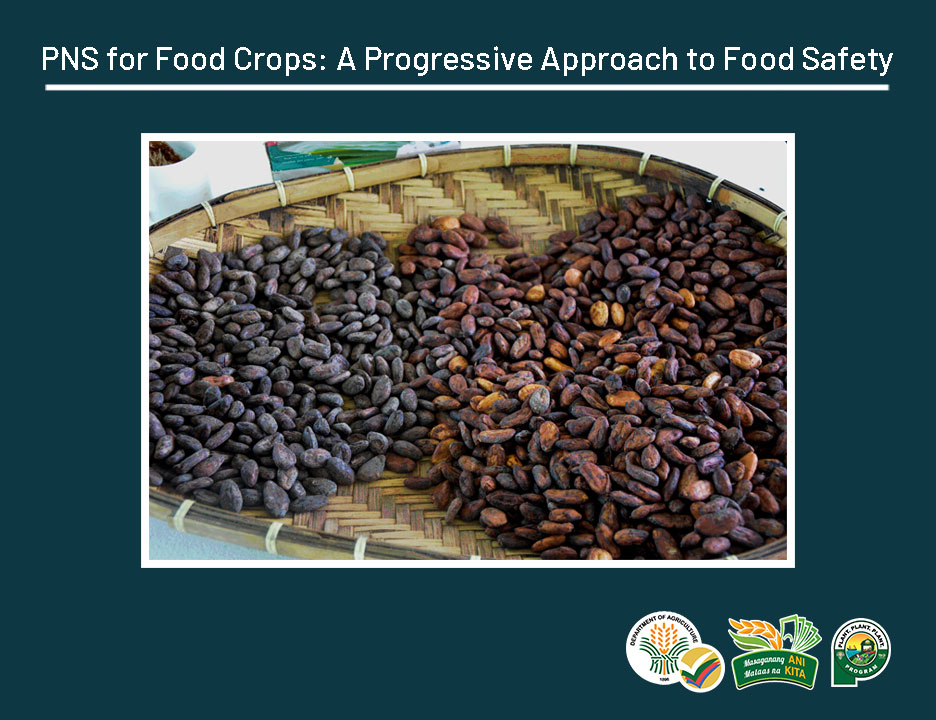
December 22, 2020. Food is a vital component of life. In the Philippines, agriculture plays a major role in the production of food. However, accessibility to quality and safe food is not ensured if standards are not established.
 As mandated by the Republic Act 8435 or the Agriculture and Fishery Modernization Act of 1997 and further strengthened by Republic Act 10611 or the Food Safety Act of 2013, the Bureau of Agriculture and Fisheries Standards (BAFS) is the sole mandated agency under the Department of Agriculture to develop Philippine National Standards (PNS) for the quality and safety for food crops. The PNS for Food Crops aim to provide a common understanding on the product specifications and practices, through establishment of minimum parameters on grading, classification, and code of practices.
As mandated by the Republic Act 8435 or the Agriculture and Fishery Modernization Act of 1997 and further strengthened by Republic Act 10611 or the Food Safety Act of 2013, the Bureau of Agriculture and Fisheries Standards (BAFS) is the sole mandated agency under the Department of Agriculture to develop Philippine National Standards (PNS) for the quality and safety for food crops. The PNS for Food Crops aim to provide a common understanding on the product specifications and practices, through establishment of minimum parameters on grading, classification, and code of practices.
The codes of practices for food crops can be further categorized under Good Agricultural Practices (GAP), Code of Practice (COP) and Code of Hygienic Practice (COHP). GAP in food crops provides practices implementing best management practices that help reducing the risks of microbiological contamination of fruits and vegetables. Example of GAPs that have been developed for food crops are the GAP for Mango (PNS/BAFPS 45:2009), GAP for Fresh Fruits and Vegetable Farming (PNS/BAFS 49:2017), GAP for Corn (PNS/BAFS 20:2018), and GAP for Cassava (PNS/BAFS 150:2020). On the other hand, COP including COHP provides guidance in the production, processing, manufacturing, transport, and storage to ensure the safety and suitability of food for consumption. Example of COPs and COHPs that have been developed are the COP for Philippine Cocoa Beans (PNS/BAFPS 104:2011), COP for Packaging and Transport of Fresh Fruits and Vegetables (PNS/BAFS 198:2017), COHP for Gabi Leaves (PNS/BAFPS 166:2015), and COHP on Processing and Handling of Corn Grits (PNS/BAFS 142:2018).
One of the vital areas in food safety standards is setting the Maximum Residue Limits (MRLs) of Pesticides. The PNS for MRLs of Pesticides in Crops provides information on the set limits of pesticide residues on a specific commodity in the Philippines. This aims to promote consumer protection against harmful effects of pesticides and also serves as a trading policy among trading partner countries in the international trade. In the country, the DA-Fertilizer and Pesticide Authority (FPA) is the regulatory agency responsible for the registration of pesticides and its MRLs for a specific commodity. On the other hand, the DA-Bureau of Plant Industry (BPI) is the mandated agency to regulate the import and export of food crops in terms of MRLs.
Out of the 152 PNS for agricultural commodities (food and non-food), 135 PNS were developed for food crops which is composed of 102 PNS for product standards and 33 PNS for code of practices. These 135 PNS for food crops can still be broken down into: fruits (38 PNS), vegetables (40 PNS), maximum residue limits (8 PNS) and other food crops (e.g. cassava) (49 PNS).


PNS are voluntary in nature. It can become a technical regulation once adopted by a regulating body. In the Philippines, the technical regulating body responsible for the surveillance and monitoring of food crops depend on the mandated agency. For example, enforcement of standards for fruits and vegetables in general is under DA-BPI. For coconut and coconut products, this is a responsibility of Philippine Coconut Authority (PCA).
Nevertheless, the establishment of PNS is essential in order to ensure accessibility of quality and safety food crops. The standards also serve as an applicative tool to the farmers and in producing good quality of agricultural products which are consumed by the general public. Lastly, the said standards address food safety issues that may be encountered at any point of the food value chain from production till consumption.
